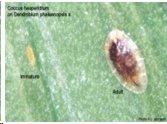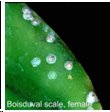Orchid Pests: What They Look Like and How To Deal With Them
Any discussion about orchid care needs to also cover orchid pests and orchid diseases. So let’s take a little time and discuss these two facets of orchid care.
For the most part orchids are relatively free of pests. But like any plants that are cultivated for some time eventually you will have to deal with orchid bugs) or diseases.
The best way to help deal with diseases and orchid pest problems is to prevent them from the very beginning. And one of the best ways to do that is to be observant with respect to your orchid plants. Make a habit of inspecting your plants on a regular basis. Make sure you look under the leaves and in the bracts as well. Being vigilant will save you a lot of time later. Another great suggestion to help prevent problems is to sterilize your tools prior to working on your orchids. If you are just doing some quick cutting I recommend that you use one sided NEW razor blades. And discard them after using them on one plant. Or if working on very diseased material discard them when going from the diseased material to the healthy material.
Let’s talk about the most common orchid pests.
As I mentioned before it is important when you notice pests it is important to quickly know what you pest you are dealing with and then promptly act to apply the most appropriate control. Because many insects reproduce quickly you may have to treat the plants several times to kill the offending pest and their subsequent offspring.

Aphids:
Aphids are a very common insect pest for many plants. They can be in many colors like green in the picture above or red, yellow, black, orange, pink or beige. They are often found on the new more succulent growth such as flower buds or new leaves and shoots. Like Scale and mealy bug they are sucking insects. They can deform the part of the plant that they are feeding on. They can also be vectors for carrying disease like bacteria and virus.
Treatment:
Initially you can try washing them off with warm water, that is physically removing them. If they are more persistent then try in this order: Insecticidal soap, orange oil, horticultural oil, isopropyl alcohol and lastly Bayer Advanced Flower and Flower Insect Killer.
Thrips:
Thrips are less common in my experience but nonetheless they can be very destructive. They like to target young leaves, maturing flowers and flower buds. These are tiny flying insects that look something like long gnats. Do not confuse them with fungus gnats! They are hard to see without a hand lens because they are so tiny.
 |
 |
Scale:
Scale is a very common pest. I know about scale. I have it from time to time. This is another insect that has various forms. Most scale have a hard shell that protects the soft insect body inside that armor. this shell helps protect the insect and makes it harder to kill with alcohol, pesticides and physical removal. Scale is often found on the underside of leaves or on the edge of the leaf or in the bracts of the plant. It is hard to eliminate but with diligence and persistence it can be controlled. And if you find it, you must try to eliminate it for the health of your orchids.
Spider mites:
These tiny little insects are troublesome orchid pests but they are not spiders. They are hard to see but even for their small size they can be very destructive pests. They are more prone to show up where growing conditions are hot and day. They can be a number of colors but even colored they are difficult to see without a hand lens as they are so small. Very serious infestations will be more noticeable as these mites produce a fine webbing like a spider web, hence the name. In serious infestations the foliage may take on a stippling appearance which is a result of the feeding of the spider mites.
Mealy bug:
This insect looks like cottony masses often hiding on the growing tips, and buds and flower stems. And sometimes hidden in the bracts and under the sheaths of the pseudobulbs. It is happy in similar areas as are aphids. This is a difficult insect to eliminate and will often require repeated treatments with insecticides to get rid of it.

Slugs and snails:
Slugs (no hard shell) and snails (hard shell) are common orchid pests and a challenge for lots of other plants. They can do extensive damage to young orchid roots and stems and also the flowers as they develop and mature. Slugs and snails are usually night creatures so if you suspect that these are the problem then it is best to go out at night with a flashlight to determine that slugs or snails is really the pest that is the problem. These creatures tend to hide under flower pots and in the cool damp spots. Both slugs and snails leave a trail of their passage across dry surfaces.
Roaches:
Personally I have not experience with roaches as orchid pests as they are not a common insect where I live. But I do see it in the orchid literature. Apparently they feed at night and can eat flowers and buds. I would suspect traps or appropriate pesticides (again be careful!) would be of help.
Mice:
While I have plenty of field mice in the country area where I live, my orchids are generally not a food source so I do not personally consider them orchid pests. But that is not always true for those of you growing in other locals. Mice will eat the buds off orchids just as they are getting ready to flower. This is of course very frustrating.
Bees:
It is important to note here that BEES OF ALL KINDS ARE NOT PESTS for orchids. To the contrary, bees are the friends of any gardener or plant person. Please do nothing to injure or kill bees. They are critical to the health of the planet and to us and they are suffering these days. It is probably important to mention that if any insect does pollinate an orchid flower that flower then will die off as the plant begins to set seed. So unless you are consciously hybridizing orchids pollination of the flower is not desirable.


